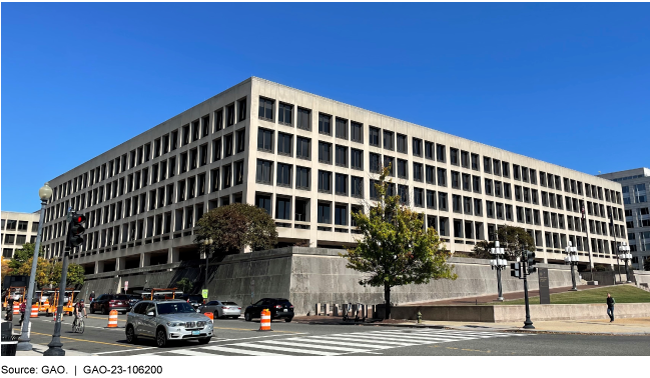With most agency headquarters at 25% capacity, ‘hard decisions’ coming for federal office holdings
17 of 24 agency headquarters offices are at or below one-quarter of full capacity, the Government Accountability Office found in preliminary findings from 2023 ...
Out of millions of square feet in federal property holdings, many agencies are sitting at or below 25% capacity in their physical office footprint.
The space-to-occupancy ratio at agency headquarters has worsened in the last few years, as many agencies embraced hybrid work and increased telework for their employees.
It would be easy to blame underutilization of office space entirely on the spike in telework after the COVID-19 pandemic, but years of reports from the Government Accountability Office have shown that the problem is more complicated and long-term. Federal property management has been an issue for agencies for decades — and has remained on GAO’s High Risk List since 2003.
After surveying 24 agencies about their headquarters offices in D.C. between January and March this year, GAO’s preliminary results, published Thursday, showed every single one of them had excess space — and 17 of them were at or below 25% occupancy from staff members.

The new findings from GAO sparked heightened criticism from lawmakers on the House Economic Development, Public Buildings and Emergency Management Subcommittee.
“I’ve been a firm believer that if agencies aren’t using their space, they’ve got to give it up,” Chairman Scott Perry (R-Pa.) said during a subcommittee hearing Thursday. “We need to get a handle on this and push agencies … If they won’t do it, we’re going to have to help them do it. And I don’t mean help in the good way.”
The hearing Thursday followed after a subcommittee roundtable in March, when Perry said the growth of telework over the last several years meant agencies must “shed unneeded real estate.”

Now, GAO’s new numbers, coupled with a timely crossroads for agencies, present a “unique opportunity” to downsize federal office holdings imminently, said David Marroni, GAO’s acting director of physical infrastructure.
“It takes time to consolidate space, to dispose of space, so there is a tail to this as well, which is why decisions soon are important,” Marroni said during the subcommittee hearing Thursday. “We have a particular need now to refocus and potentially make some hard decisions about what space we need.”
Agencies have been holding onto too much space for years, Marroni said. Many decades-old headquarters buildings are not configured efficiently, and as technology has improved, agencies have fewer employees doing the work and less need for big offices, which has led to an increase in unused space.
“They have administrative spaces, storage spaces and some libraries that aren’t as relevant in modern workplaces, but that takes up the usability of your space,” Marroni later told Federal News Network.
Some subcommittee members pointed to the new GAO report as good reason to return federal employees to the office. Many agencies, including the Department of Veterans Affairs, the Federal Emergency Management Agency (FEMA) and the Federal Deposit Insurance Corporation, have already started announcing return-to-office plans, after the Biden administration in April called on agencies to submit updated work environment plans and increase in-office work where necessary.
OMB’s guidance is a key way for agencies to decide how much space they’ll need going forward, but Marroni said it’s not a full solution to the challenge of office holdings. Because of outdated configurations of office space, even if an agency had 100% attendance of staff assigned to a particular building on a given day, by GAO’s calculation, it would still only be about two-thirds utilized.
“It’s not just because of telework that we have these low levels of utilization, but it certainly has driven numbers lower than they were prior to the pandemic,” Marroni said. “There’s a particular opportunity right now to say, ‘How much attendance do we want staff in the building going forward? What does that mean for these spaces? Do we need all this space, or can we consolidate? Can we dispose of space we don’t need?’”

Still, many agencies have yet to make their return-to-office decisions, which leaves office holdings up in the air, too.
“The truth is, we’re still in the middle of this shift in the real estate market, and this could take a long time to play out — we need to recognize that,” Subcommittee Ranking Member Dina Titus (D-Nev.) said during the hearing. “But returning to work is only part of the issue at hand.”
The other part of the equation? More than 50% of the General Services Administration’s building leases will expire within the next five years. Even though it’s years away, agencies need to start making decisions now, Marroni said. Aside from how long it takes to get through the process, there are also significant financial, environmental and opportunity costs to holding onto too big of a physical footprint.
“Every dollar an agency spends on unneeded space is one dollar that can’t be used for other priorities,” Marroni said during the hearing. “How much economic benefit do buildings used at a quarter of their capacity really provide to the local economy? Housing, hotels and other uses could provide more local benefits.”
But at the same time, it’s not easy or cheap to work toward reducing the federal footprint, said Nina Albert, commissioner of GSA’s Public Buildings Service.
“It does cost money to save money,” Albert said. “We need to move agencies from one location to another — that costs money. And where they’re moving to needs to be improved. Either in our own buildings, or into even a leased space, there’s improvements or changes that need to be made to the physical footprint to accommodate a new agency and how the new agency functions. All of those activities take money.”
To make it happen, Albert said GSA’s budget proposal will help modernize and fix the program. The fiscal 2024 budget request includes $2.3 billion for GSA’s capital program. Without stable funding, Albert said it forces the government to lease out of necessity, while still carrying space it no longer needs. She also emphasized the need to streamline GSA’s authority to maintain and dispose of real property.
“The expanded authority is not a request for additional funds,” Albert said. “Instead, the proposal allows GSA to use existing funds on analyses and activities that support agency identification and preparation of real property for disposition.”
Lawmakers also questioned the right capacity for federal office spaces, and whether there should be a set goal for agencies. There are no set standards for agencies to determine how much office space they need, but traditionally, GSA has maintained a benchmark of 180 square feet per staff member to measure the office space agencies will need.
“Especially now that we have a more hybrid work environment, those existing measures, even the 180 may not make sense going forward,” Marroni told the subcommittee members.

The Public Buildings Reform Board (PBRB), created under the 2016 Federal Assets Sale and Transfer Act, was created with the intention of fast-tracking the sale of excess federal properties, but the board is falling behind on its goals.
Though it was able to sell $194 million worth of properties, PBRB is still hundreds of millions below its targets. The board has since faced rejections from OMB of additional property sales, and lost quorum after two PBRB members vacated their positions at the end of 2021. PBRB regained quorum in November 2022, and is preparing its final round of recommendations before the board ends in December 2024.
And with return-to-office plans still undecided for many agencies, many have been reluctant to give up the space they already occupy.
For Marroni, the preliminary results from GAO were not surprising, but there is a bigger takeaway for agencies. To start downsizing, agencies should look at how much space they have, how many employees they’re expecting to come to the office and how often.
“The numbers themselves, they jump off the page, but we expected to find low utilization,” he said. “If you walk around the D.C. core, I don’t think that’s shocking to anyone. But the numbers do highlight … that we do have a utilization issue right now. It’s important for agencies to assess where things stand and assess where they want to go in the future.”
GAO plans to release more studies in the coming months, including one with recommendations for how agencies can more specifically address office space underutilization, and another looking at the effectiveness of telework for federal employees.
Copyright © 2024 Federal News Network. All rights reserved. This website is not intended for users located within the European Economic Area.
Drew Friedman is a workforce, pay and benefits reporter for Federal News Network.
Follow @dfriedmanWFED





